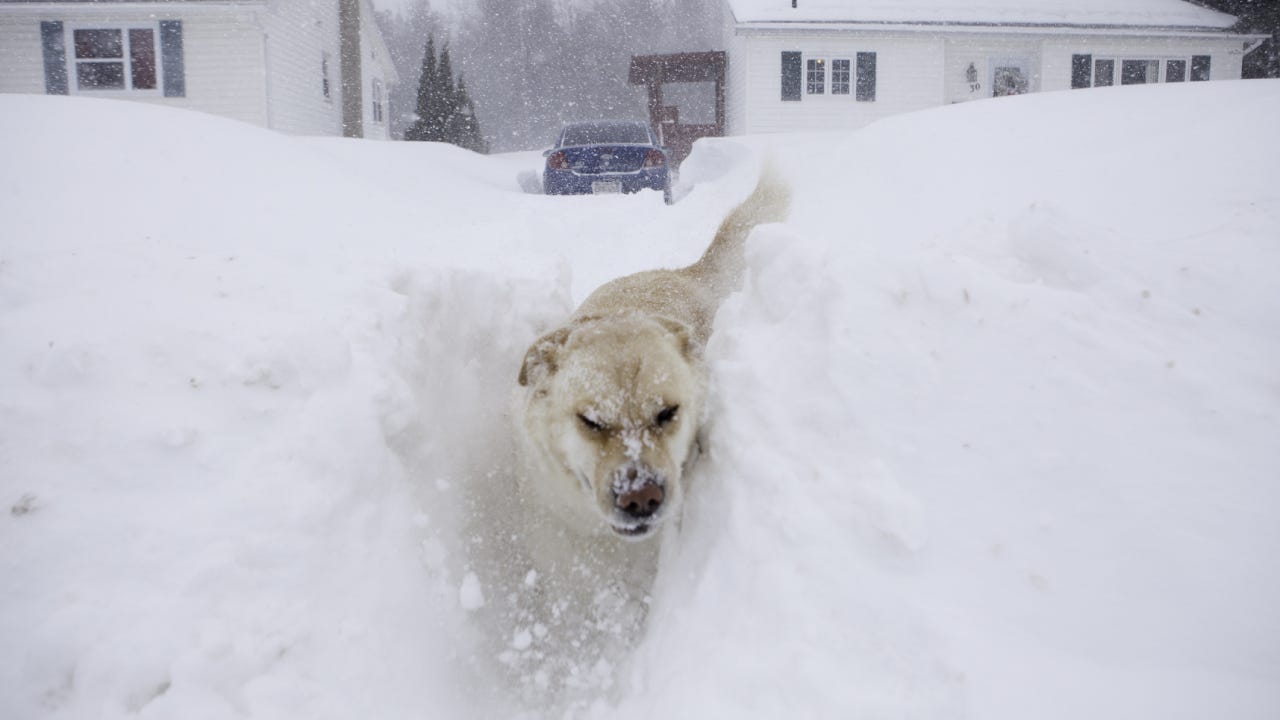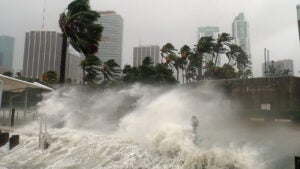The most expensive winter storms in US history




We have had winter storms named Snowmageddon and Blizzardzilla, and in the first week of 2025, two-thirds of the country was hit by Blair, a polar vortex. Over three days, winter storm Blair (an unofficial name created by The Weather Channel) spread heavy snowfall, sleet and freezing temperatures from the Pacific Northwest to New York and as far south as Texas and Georgia. While homeowners insurance typically covers damage caused by blizzards and other winter hazards, it doesn’t cover everything. Explore the most costly winter storms in U.S. history to better understand the potential damage and mitigate related risks.
The worst winter storms in U.S. history
In the coming weeks, we will understand the financial and emotional toll of January 2025’s polar vortex, but we only have to look back to around the same time as last year to get a good idea. On January 14, 2024, an arctic blast caused an estimated $1.9 billion in damage and 41 fatalities. The winter storm lasted four days and hovered over Central and Southern states. However, this wasn’t the most expensive winter storm to wreak havoc in the U.S. — it’s not even close.
According to the Insurance Information Institute, the following are the five most expensive winter storms in U.S. history, adjusted for inflation to 2023 dollars.
Polar vortex of 2021
The Great Texas Freeze in February 2021 introduced the term polar vortex and caused every county in Texas to be placed under a winter storm warning. The freezing temperatures lasted more than eight days, forcing over 10 million Texas residents to go without electricity and causing pipes to burst and a chain of other damaging events from car accidents to bare shelves at grocery stores. The end result was winter storm damage impacting 26 states and costing more than $17.4 billion.
December storm of 2022
The winter storm of December 2022 covered the Central and Eastern regions of the U.S. but may have hit Buffalo, New York, the hardest. Hurricane winds and snow squalls caused massive structural damage to buildings and infrastructure and 47 residents died. Across the country, more than a million customers were without power, and losses totaled more than $7.9 billion.
The Storm of the Century
In mid-March 1993, the “Storm of the Century” swept across the U.S., impacting nearly half the nation’s population. With wind speeds equivalent to a Category 3 hurricane, the storm caused an estimated $4.4 billion in damage. The storm was notable not only for its size and cost but also for its intensity, resulting in tornadoes, heavy snowfall, extreme cold and coastal flooding. Despite the severity of the storm, the National Weather Service’s accurate forecasting and the public’s heed to warnings played a critical role in lessening the storm’s impact.
February storm of 2015
The winter storm of February 2015 significantly impacted the Northeast, particularly Boston, which recorded its highest-ever monthly snowfall. The storm wreaked havoc on transportation systems, leading to road closures and flight cancellations. The South was also affected, with regions like Alabama, Mississippi and Georgia experiencing their most substantial snowfall in more than 10 years.
December 1983 storm and cold wave
The December 1983 storm and cold wave caused the chilliest Christmas on record in Northeast Ohio and Northwest Pennsylvania. The storm resulted in snow drifts towering between 10 to 15 feet due to 6 to 20 inches of fresh snow. The freezing temperatures lasted for several days, affecting the entire continental United States, except for the Southwestern deserts.
The damage caused to homes by winter storms
According to the Center for Disaster Philanthropy, climate change is causing extreme winter weather to occur in warmer climates, where homeowners might not be prepared. There are four main types of winter storms: blizzards, ice storms, lake-effect storms and snow squalls, all of which can create a blizzard of problems for homeowners, from minor inconveniences to severe structural damage. Here’s a breakdown of the most common types of winter storm damage:
- Frozen and burst pipes: Winter’s plunging temperatures can cause the water inside your pipes to freeze. When this happens, the pipes can burst, leading to water leaks and potential mold problems.
- Drain backups: The freezing and thawing cycles common in winter can lead to blocked drains, which can create significant issues, including unsanitary living conditions.
- Ice damming: Ice accumulation on your roof can prevent melting snow from draining properly. This can lead to water seeping under your roof shingles, causing leaks inside your home.
- Gutter damage: Heavy snowfall can weigh down your gutters, causing them to bend, break or detach from your home. This can result in potential water damage to your property.
- Power outages: Freezing rain can snap power lines, disrupting your home’s heating systems. This raises the risk of fire and carbon monoxide poisoning if alternative heating methods are used improperly.
- Wind/hail damage: Winter storms can also bring hail and high winds, which can cause significant damage to your home’s exterior, including the roof, siding and windows. From fallen tree branches to flying objects, your home and vehicle may be impacted.
Given these potential issues, it’s crucial for homeowners to prepare for winter weather by inspecting and maintaining their homes — even in areas where winter storms don’t traditionally occur. This includes ensuring that your property is properly insulated, your gutters are clean and you have a contingency plan in place for potential power outages.
Winter storm damage covered by home insurance
Most standard homeowners insurance policies provide coverage for winter storm damage. However, some insurance companies have started to limit or exclude certain types of extreme weather coverage from policies to mitigate losses. While these changes usually pertain to wildfires, winter storms can cause high winds, which can also be excluded or have a separate percentage-based windstorm deductible.
Below are common insurance coverage types included in standard policies that offer financial protection against most winter storm damage:
- Dwelling coverage: This is the most essential element of a home insurance policy and covers the structure of your home. If a falling tree damages your home during an ice storm, you sustain water damage from a broken pipe or your roof is impacted by winter hail or severe winds, this is the coverage that would apply.
- Other structures coverage: This coverage type works similarly to dwelling coverage, but it covers detached structures like sheds, gazebos, fences and detached garages.
- Personal property coverage: If your belongings — including furniture, clothing, jewelry or home decor — are damaged during a winter storm, this coverage is essential. You can choose either actual cash value (depreciation is factored into your claim) or replacement cost coverage (provides full value replacement).
- Additional living expenses: If you aren’t able to live in your home due to a covered loss, this coverage could pay for temporary housing at a hotel or rental fees, restaurant meals and even pet boarding.
Winter storm damage not covered by home insurance
Keep in mind that most policies have insurance exclusions that limit or do not cover specific types of damage caused by weather. Also, insurance carriers can deny a claim if the home shows signs of neglect or has been left vacant. In some cases, you can add coverage by purchasing an endorsement, or you may need to buy a separate policy.
Some types of winter damage typically excluded from home insurance are:
- Flooding: Flooding is excluded from most home insurance policies, but homeowners can buy coverage through a private carrier or the National Flood Insurance Program (NFIP). Flood insurance only pays out when the event meets the official definition of a flood.
- Freezing: Water damage from freezing pipes is usually excluded from home insurance, unless the homeowner took steps to prevent the pipe from freezing, such as maintaining heat in the home. Additionally, other structures like patios, swimming pools, fences and docks damaged from freezing, thawing or the weight of snow are also usually excluded.
- Landslides and mudflows: A landslide or mudflow is more likely to occur after large amounts of snow and ice melt. Both perils are usually excluded from home insurance, but a flood policy can cover mudflows, and a difference in conditions (DIC) policy can potentially cover landslides.
Winter weather preparedness and mitigation
Several strategies can enhance disaster resilience during winter storms. These preventative steps can range from how your home is designed to simply keeping up with lawn maintenance. Here are a few strategies to consider.
- Protect pipes from freezing: Water pipes should be located within the insulated parts of buildings to prevent freezing. Consider investing in pipe insulation or heat tape and don’t let your thermostat drop below 60 degrees.
- Invest in a backup standby or portable generator: If someone living in your home relies on medical equipment, having a backup standby generator to kick in during a power outage can save their life. For heaters and small appliances, a portable generator can be a more cost-effective option. (If you do keep a generator inside your home, it’s important to follow property safety protocols such as proper ventilation.)
- Maintain your home’s exterior: Keeping gutters and downspouts free of debris may help prevent or minimize flooding after heavy snowfall. The weight of ice and snow can cause trees to damage your roof and other structures. Trimming back tree branches before winter starts can reduce the risk of damage.
- Have an annual winter inspection: Having chimneys, roofs and HVAC systems inspected annually can alert you to a small issue before it becomes a bigger one. Not only does this lessen the chance of a claim, but it can also help you avoid carbon monoxide poisoning, which tends to increase in winter when heaters are used more frequently.
Frequently asked questions
You may also like

Rising tides and insurance costs: Coastal homeowners navigate high coverage costs

Every American is losing money due to extreme weather. Here’s how.


